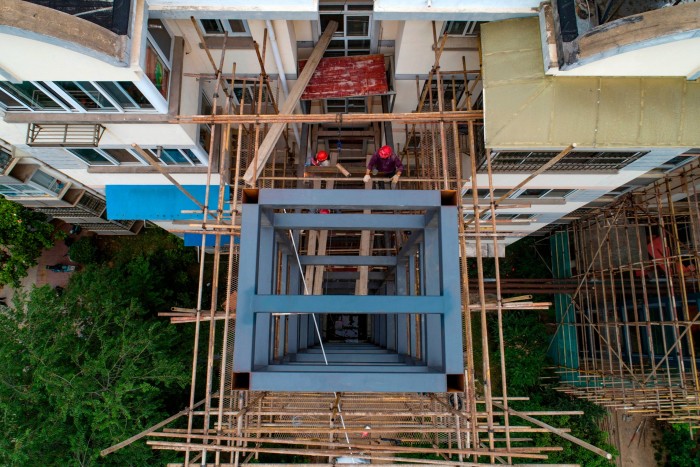
Unlock the Editor’s Digest for free
Roula Khalaf, Editor of the FT, selects her favourite stories in this weekly newsletter.
China is struggling to find money to retrofit hundreds of thousands of lifts in ageing apartment blocks as their residents also grow older, with increasingly parlous local finances making it hard to support a greying population.
In the 1980s and 1990s, millions of people moved from China’s vast rural hinterland to the cities to help power the country’s manufacturing boom. Authorities built concrete Soviet-style dormitories for these rural arrivals.
But decades on, these ageing migrants have found themselves on the wrong side of the property market downturn and worsening government fiscal health, leaving them unable to move into more modern apartments and struggling to get around their own buildings.
For 71-year-old Li, the one thing that would make her life easier would be a lift in her six-storey Beijing apartment block. “We need it,” said Li, gesturing at her legs. “But we the elderly cannot afford it.”
While a massive programme to renovate these old blocks is under way, paying for the lifts is very much up for negotiation. Overall, the plan is to install 2mn lifts across 8bn sq metres of housing stock built between 1980 and 2000, according to the housing regulator. The housing regulator did not respond to a request for comment.
But the lift installation campaign, first touted in 2018, has been plagued by conflict over who will pay, with authorities offering only partial subsidies and pushing tenants to cover the cost.
A collapse in land sales — a crucial source of local government revenue — and a broader economic slowdown have left authorities with little cash to spare. Nationwide, just 36,000 lifts were installed last year.

In Shenzhen, local governments have offered to pay up to 40 per cent of the costs, but residents have struggled to agree over payment.
In some cases, people on lower floors have expressed unwillingness to pay for their upstairs neighbours to get a lift. In others, people on higher floors have paid more. Others complain that lift installation could eat into valuable car parking space.
“I’ve given up persuading Mrs Xue on the second floor [to install a lift],” said 67-year-old Li Ling, who resides on the fourth floor of a six-storey walk-up in central Shanghai. “We never once raised our voices in arguments, and I don’t want to spoil our relationship over this after all these years.”
Last year, some local governments allowed lifts to be installed, even without consent from all floors. In Shanghai and Beijing, residents can withdraw funds from the housing provident fund, a ringfenced fund for purchasing and renovating homes, to pay for the lift.
Overall, progress is proving slow. In Shanghai, there are more than 250,000 buildings that require lifts, according to industry estimates. Yet in 2023, the city completed only 3,001 such projects, just slightly more than the previous year.
Some lift manufacturers have said they will cover construction costs and recoup expenses later from residents. The lifts, equipped with face scanners, charge residents Rmb0.20-Rmb0.85 ($0.03-$0.12) per ride.
Shenzhou Tongli Elevator has installed 200 such lifts in Shenzhen and expects to recoup its costs within 15 years.
“We do have certain requirements for the level of local government subsidies,” said Peng Wei, the company’s general manager. “If they are too low, it means companies have to invest more, and we would need to increase the fees for a single ride. That is not sustainable for us, so we started in provinces that offer sufficient subsidies for us to operate.”
In the Gaojiayuan residential compound in eastern Beijing, an area built to house state-owned electronics factory workers in the 1990s, Wang, who is in his 70s, said: “The elderly do not have high demands . . . In their later years, they just want to live with safety. If they can’t go up or down the stairs, what are they supposed to do?”